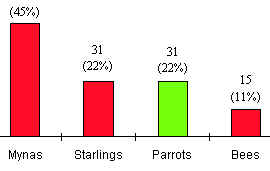Nestbox pests:
Indian myna - the problem
Indian myna - prevention
Indian myna - control
Feral bees - the problem
Feral bees - control
Brushtail possums
Ants
| Management of nestbox pests |
|
|
| Home / Contact us / Product range / Stories / Pest management / Prices |
| All of our experience suggests
that, if their needs are met, animals have no preference for a natural hollow over an
artificial hollow. So it is no surprise that nestboxes are used by pests.
|
|
One of the few Australian
studies on the impact of hollow-using pests was carried out in Canberra in 1994.
Usage of both natural and artificial hollows in two reserves was monitored for a full
year. The results are summarised in the graph adjacent and show that native animals
were excluded from about 80% of the hollows. |
 |
Some people have deduced that, because nestboxes are used by pests, it is wrong to put them up. This really misses the point. Nestboxes are of value only where natural hollows are in short supply. Because pests are so aggressive, they make natural hollows even more scarce; in other words, they contribute to the situation for which nestboxes are an answer. So it makes much more sense to seek ways to manage pests in nestboxes, which is, theoretically anyway, easier to do than managing pests in natural hollows. Unfortunately, it is not easy. Some of our pests, such as the Indian myna and starling, are among the world's most successful birds; they are not easily outwitted. This section aims to offer some hope and ideas to those trying to deal with nestbox pests. Please send us details of your attempts and results. |
|
|
|
